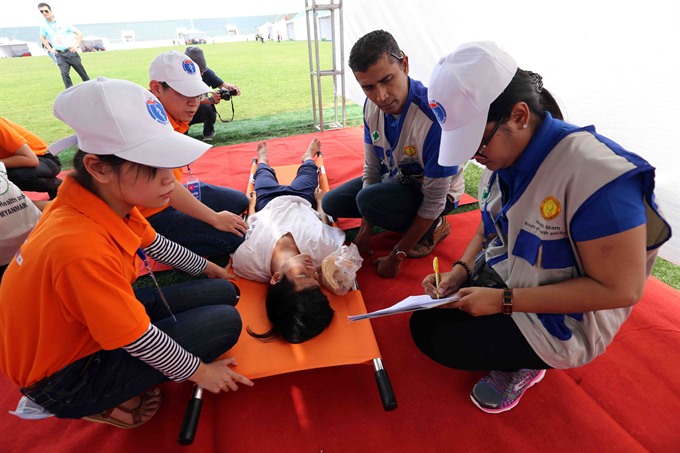 Society
Society

More than 200 members of emergency medical teams from 10 ASEAN countries and Japan joined a regional collaboration drill under the ASEAN Regional Capacity on Disaster Health Management (ARCH) project in the central city yesterday.
 |
| Staff members of an emergency medical team participate in a drill at the ASEAN Regional Capacity on Disaster Health Management (ARCH) project in Đà Nẵng yesterday. Participants from 10 ASEAN countries and Japan joined the one-day drill at Hòa Xuân Stadium. — VNS Photo Trần Lâm |
ĐÀ NẴNG — More than 200 members of emergency medical teams from 10 ASEAN countries and Japan joined a regional collaboration drill under the ASEAN Regional Capacity on Disaster Health Management (ARCH) project in the central city yesterday.
The drill challenged participants to respond to a ‘super typhoon’ with wind speeds of 200km per hour sweeping central provinces from Thừa Thiên-Huế to Quảng Ngãi, killing 500 people and wounding 800 others. In the training scenario, dozens of living quarters were isolated and nearly 10,000 victims were taken to hospitals.
ASEAN countries then responded to a call for help from Việt Nam through the ASEAN Coordinating Centre for Humanitarian Assistance (AHA) and emergency medical teams (EMT) were sent to disaster-hit areas in Việt Nam with air cargo containing logistics and medical equipment.
“In response to ‘One ASEAN One Response’, Việt Nam has enthusiastically participated in the project since 2015. It’s the second time that Việt Nam has hosted the drill with the aim of strengthening joint actions with regional countries in dealing with disaster,” Vice Minister of Health Phạm Lê Tuấn said in his speech opening the drill.
“It’s also a practical opportunity for EMTs from regional countries and Việt Nam to share experience and skills in management and planning of responses in the future disasters in the region.”
Dr. Atchariya Pangma, general secretary of Thailand’s National Institute for Emergency Medicine and director of the AHA project, said the drill, which was jointly organised by the Vietnamese and Thailand ministries of health, the Japanese international co-operation Agency (JICA) and Đà Nẵng city, drew many participants and guests.
“We have designed this field exercise to provide you knowledge and useful experiences in practising medical and humanitarian responses in an extreme disaster simulation,” Atchariya Pangma said.
“In this exercise, you learn how to manage the information; how to report for effective collaboration among the EMTs, and how to work together with various local and international agencies in the affected areas,” he said.
He added that the exercise was designed to help participating teams test the efficiency of the regional collaboration tools, namely the Standard Operating Procedure for the Coordination of EMTs in ASEAN and the health needs assessment framework that have been developed by the project working group.
In 2013, cyclone Nari killed five people and injured 49 in the central region. Five hundred homes were wrecked and nearly 12,000 others damaged in Thừa Thiên-Huế, Đà Nẵng, Quảng Nam and Quảng Ngãi. — VNS




